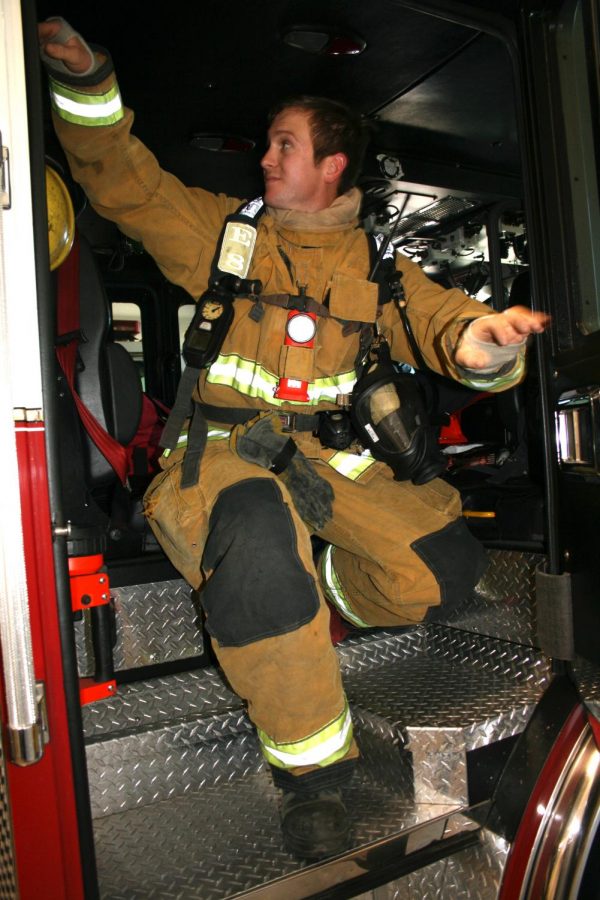Bakersfield Fire Department speaks about fire prevention
Firefighter Bill Ballard climbs out of a fire engine after demonstrating the routine of responding to a fire call.
November 1, 2017
With the recent wildfires that ravaged Northern California’s landscape, causing deaths and significant destruction of property, fire prevention is an important topic to cover.
Although Bakersfield is “vulnerable to wildfire in the urban interface area,” according to Deputy Chief Tyler Hartley from fire station #8, “it is unlikely we would experience the total devastation seen in Napa California this year.” Hartley said that there are enough local deployable resources to contain a fire in the event of “local-wind driven fire events.” It is not out of the question, though, that Bakersfield could experience “multi-structural loss” involving shake-shingle roofs in older neighborhoods.
Hartley, an experienced fire instructor with 29 years of experience with fire service, manages fire station #8, which is across the street from Bakersfield College and is the first responder for emergencies at BC.
“Fires are driven by three factors: fuel, topography, and weather,” according to Hartley. Bakersfield topography is predominantly flat, except for Northeast Bakersfield where the topography “could enhance fire-spread.” High winds present dangerous conditions for fire fighters.
Hartley says that the Cottonwood Fire on Oct. 9 was driven by high-velocity winds that resulted in the loss of structures, livestock and property on flat topography. Therefore, there are dangers of fire-spread when wind is introduced, regardless of any location in Bakersfield.
The majority of fires are preventable, though, according to Hartley. Most of the fires in Bakersfield are not “weather-related, but human related.”
In fact, “50.8 percent of fires reported are caused by cooking,” Hartley said.
Home heating fires fall under the second most reported fires, according to John Frando, the Bakersfield Fire Department’s Public Information Officer. Frando advises people to make sure that portable heating units have at least a 3-foot clearance from anything that might catch on fire, such as drapes. He also advised to make sure that it has an automatic shut-off feature in case it is ever tipped over by children or pets.
Other factors, which fall below the 10.8 percent threshold, include heating, electrical malfunctioning, open flames like candles, arson, appliances, smoking, and children that play with heat sources.
“We believe that most fires can be prevented, and the Bakersfield Fire Department dedicates a lot of time to public education,” Hartley said.
To protect your home and property, Hartley advised that “proper clearance around homes” should be at least 100-foot clearance from the home in urban areas.
Ideally, this would mean that property owners should remove any tall trees or shrubs to meet the safety clearance. Yearly property maintenance of weeds and grasses, pruning and removing dead wood accumulation, will decrease chances of fire-spread. Wood shake roofs, as mentioned previously, also pose significant risks.
Should the fire department need to respond to a fire in urban areas, adequate turnaround space should be made so that the fire engines can get to the back and side of the home.
It is also important to have the proper fire extinguisher on hand. Choosing the correct fire extinguisher for the type of fire a resident might encounter is the difference between being able to control and extinguish the threat and the fire getting out of control. Having a multi-purpose fire extinguisher is useful in containing dry chemical fire, carbon dioxide fire, grease fires, and electrical fires, according to Frando. Fire extinguishers should not be stored under a cabinet, or stove, but placed somewhere easily accessible, such as in a pantry or near the entrance or exit of the dwelling.
One of the common concerns of residents is what to do should the pilot light go out on the stove, water heater or furnace this winter. Hartley suggests that residents use caution if they should relight the pilot light. Make sure there is no odor of gas. If there is an odor, he suggests closing the gas shut-off valve on the appliance, evacuating everyone from the dwelling, and to call the gas company immediately. If there is no gas odor, for safety precaution, before relighting the pilot light, open windows and doors to allow the room to air out for at least five minutes.
Helpful fire prevention tips were posted on Bakersfield Fire Department webpage during the first week of October.






